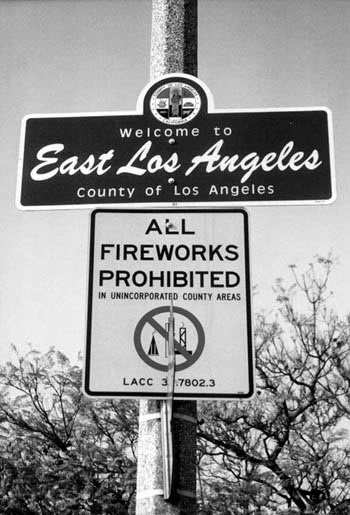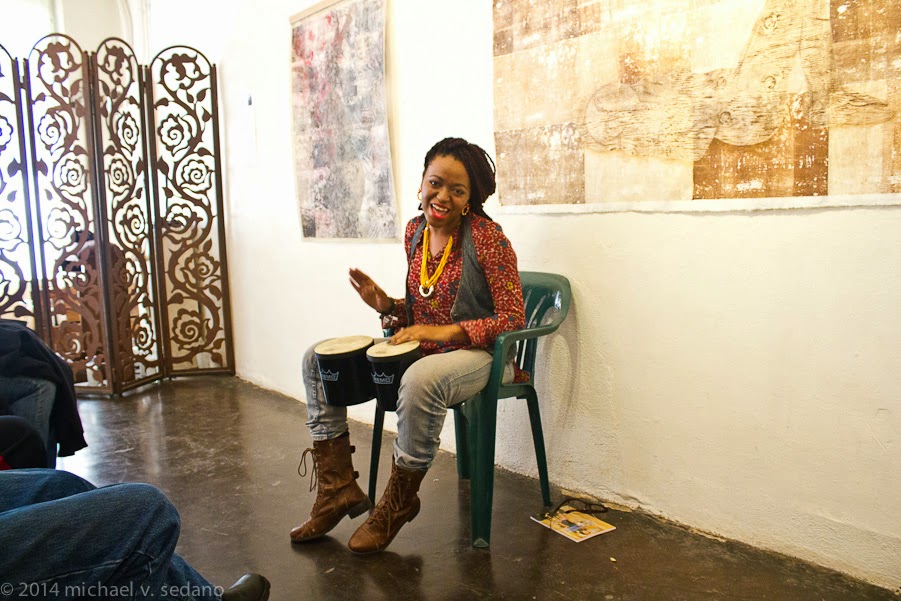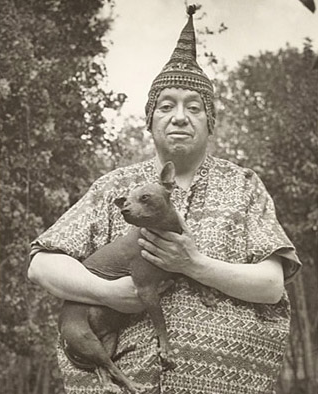La Palabra Hosts Bloguera Xánath Caraza, Shy But Flyy, and Debuts Eric "Praxis" Contreras
It was Karineh Mahdessian's third time at the helm of the monthly reading series, La Palabra, at Northeast Los Angeles' Avenue 50 Studio.
She hit her stride. Unfazed by a featured reader's late arrival and Xánath Caraza's time-certain departure an hour after the 2:00 opening, Karineh improvised with aplomb.
Mahdessian altered the series' pattern of Open Mic and Featured Reader. In this instance, Open Mic launched the afternoon, the Featured readers came next, another Open Mic, and an engaging Q&A followed.
Bloguera Xánath Caraza's reading included work from Conjuro, including the heart-thumping
Yanga that had the audience dancing in their seats to the intoxicating rhythm of the Afro-Latino influenced text.
A special moment in the reading. Caraza's latest collection, Noche de Colibríes: Ekphrastic Poems, features cover art by Heriberto Luna. Caraza had not met the artist, whose studio is in the Avenue 50 complex. Luna joined the audience for Caraza's reading of Luna's poem.
Madhessian holds Luna's Tree of Life painting featuring the cosmic hummingbirds of the cover as Xánath reads the piece inspired by the painting. After, Luna tells me he enjoyed the heck out of the experience.
Southeast Los Angeles' Eric "Praxis" Contreras made his featured poet debut at La Palabra, his name had never been on a poster. Mahdessian disclosed that Contreras will soon be a household name when a feature LATimes article appears.
Contreras writes feminist poetry, sharing a powerfully constructed piece in the voice of a woman. He tells the audience his grandmother and mother are the dominant influences in his life, and he rejects the attitudes of some pendejos who don't understand nor value women.
Eric's motivations for poetry extend from the personal to the community. His home city of Bell is notorious for government corruption, but also for its dramatic absence of a cultural life.
Contreras works to fill the void by holding
Alivo Open Mics in his garage.
Alivio brings in a crowd of young adults and neighborhood viejitos to share their own, or hear others' poetry.
It's those crowds of gente coming to some vato's garage to do a floricanto that brings the LA Times' Ruben Vives (who broke the Bell corruption scandal story) to shadow the high school substitute teacher for the feature.
In addition to
Alivio, Contreras hosts a biweekly reading at
Corazón y Miel Restaurant in Bell.
Find information on the Alivo series and Corazón y Miel, via
Eric's Facebook page, don't wait for the LA
Times article.
If she's shy she holds it back and lets loose with a frenetic array of musical poetry that led an already exhausted audience to higher levels of energy and joyousness.
Shy But Flyy's harmonious blend of spoken word, song, and drumming provided La Palabra's house with a stirring example of poetry out loud y con ganas.
Shy But Flyy organizes poetry readings from her Long Beach area residence. La Bloga looks forward to learning and sharing more about these events at the far southeast of LA County.
Open Mic at La Palabra
A sense of community and carnalismo develops among the gente attending a La Palabra meeting. Much of this grows from the Open Mic. Open means anyone, from a trembling novice reading their stuff to an audience for the first time, or experience veterans like Jessica Ceballos and Luivette Resto, or Joe Kennedy. I'd not heard Charlie Zero, lower right, read before.
For the most part, today's readers omitted the most valued element of a reader's nonverbal communication--eye contact. It's a problem of handling the manuscript, but also of lack of confidence.
Here are Flor de Té, Angel Garcia, Karla Sanchez, and William A. Gonzalez. Two got stuck to their manuscripts while Angel and Karla had a bit of eye contact.
Rebekkah Bax read her selection from Mahdessian's
Heartbreak Anthology. When a piece is quite short, the reader should allow herself a slow pace to avoid the
look down look up and she's gone effect. It stymies photographers.
Karineh handled the Q&A effectively. The loquacious audience had lots of questions and the two featured readers elaborated effectively on their answers. Shy But Flyy hedged her story about her earliest writing performance. Her mother spills the beans in the lower right foto, telling how the precocious three-year old demanded an audience for her compositions. That patience worked, Ma, the kid is a wonderful performer.
Reading Your Own Stuff challenges every writer from the laureates to the rookies. See the
"Reading Your Stuff Aloud" pages at Read! Raza for tips on eye contact, handling manuscripts, delivery, and memorization.
Here's a link to individual portraits.Twenty Little Helpless Souls
La Bloga friend Edward Vidaurre is one of four editors of a sadly needful collection of poems. Twenty honors the twenty treasures who were shot by a man armed with a rifle and a broken mind. The babies were six, and seven, years old.
Nothing like this should happen, ever. Yet, the December 2012 shootings in Newton CT stand in a long line of United States cultural markers outsiders can point to and say, “that is ‘American’ culture” and they mean you.
It’s a rhetorical situation that calls for poetry. That perception of who we are demands a counterstatement as loudly heard as bullets. Twenty: In Memoriam is counterstatement, fifty-five poets stepping forward in communal expression of who we are. Photography and art embellish the collection. Many of the poets, like Vidaurre, are from the Rio Grande Valley. Poets Laureate Juan Felipe Herrera and Carmen Tafolla contribute, as well as several La Bloga friends and On-line Floricanto poets, including Nancy Aidé Gonzalez, Iris de Anda, and Claudia D. Hernandez. Hernandez’ fotos are a notable bonus to the book.
In his “Introduction Writing Kindness,” Juan Felipe Herrera tells us, “These poems speak wisdom. It is hard to find it – perhaps you must fall into each other, bathe in the palms of intertwined hands ripped by shrapnel and sense the sublime there, flowering, in those wounds.”
Editor José Chapa V recalls, “When I was approached with the offer to help curate TWENTY, I had mixed feelings. We knew that on one hand, the poems would seek to commemorate and honor the victims of the tragic shooting, and that on the other they would be probing darker areas than the usual poetry anthology. I wasn’t sure how to go about it, if the work that arrived (regardless of quality) would fit such delicate criteria, and what kind of response our gesture would gather. But I decided to join the editorial team on the knowledge that such events have an impact not just on the victims and their families, not just on our nation, but on the entire human species.”
Editor Vidaurre explains a powerful feature of the collection.
Twenty-eight lives were lost. This book is dedicated to the educators that lost their lives as well. Page 20 in this anthology is left blank, purposefully: we ask that when you come across it, you say a special prayer, close it for a bit and reflect, write your thoughts, a poem, a song, or bring the book to your chest and hold it.
The book comes from McAllen, Texas and El Zarape Press. The collection presently has distribution only from Amazon, though the press promises alternative distribution in future. Use ISBN-13: 978-1494326753 or ISBN-10: 1494326752 with your local bookseller to order. Some money from sales will go to charities serving children.
Más Tequila Review Hits the StreetsThat’s old newspaper talk for a new edition. Unlike the newspapers or yore, a new edition of an independent poetry journal like
The Más Tequila Review doesn’t have streetcorner urchins shouting “TMTR, get yer TMTR” on every block.
Headquartered in Alburquerque, New Mexico,
The Más Tequila Review is the love child of Richard Vargas and the muses of poetry. The current issue, Vargas confesses, has a new look because he accepted too many poets to fit the normal press run. Euterpe and Erato were whispering in Vargas' ears as he's featuring Jazz Poetry in the issue.
For information on ordering the $7.00 collection—I proofed this copy, the price is seven U.S. dollars--
click here for the Facebook TMTR page, and
here for the TMTR website.Free La Tolteca ‘Zine In its fifth year, La Tolteca ‘Zine sets itself up as a sassy, thoughtful resource for razacentric writing with an actitude, or make that a twist.
In 2012, La Tolteca promised its December issue would be “more exciting, original thought, images & literature to boggle your mind, put a jiggle in your wiggle & bring you closer to the gods. Strap on your seat belt or something & subscribe. It’s the only thing you’ll get this season for free + our love.” A year later, staff was telling readers, “Subscribe now! It’s free! Pass on to your high falutin’ thinker friends, poet acquaintances and barely literate family members who like the arts. There’s something for (almost) everyone, who thinks, supports the arts and occasionally still reads. Happy holidays with love from la tolteca staff.”
It’s free.
Getting there is half the fun.
Click on this Facebook link to learn more about the process.
The ‘Zine marks one of those labors of love that busy people take on because they have to. As if she didn’t have her hands full writing and workshopping writers and living her life, Ana Castillo is la éminence grise of La Tolteca.
La Tolteca arrives on your desktop as a deluxe interactive graphic with the look and feel of a print magazine. There's a special bonus for gente who've joined one of Ana Castillo's workshops. Some get to work on the 'Zine, plus the 'Zine runs contests open to workshopistas.
Latinopia Scrolls![]() |
| Six-column layout is easy-to-read. Magnifying or shrinking your browser window gives fewer or more columns. |
One of my favorite Chicana Chicano media sites is
Latinopia. It’s a visionary place that keeps growing.
Film maker Jesus Treviño shares his enormous video library in multiple small portions. He updates the site weekly. One week he might have José Montoya reading “El Louie,” another week he will share a few minutes from a documentary spotlight on ASCO. And each week there will be six other highlights just like those.
Latinopia shows contemporary as well as historic video. Treviño regularly captures community events—see RudyG’s
reading--plus conducts interviews with a variety of people from artists like Sonia Romero or Linda Vallejo to performances by Ruben Guevara or Conjunto Aztlán. Book reviews, Serge Hernandez’ resurrected Arnie and Porfi cartoon that originated in Con Safos Magazine, and the Zombie Mex Diaries, make regular appearances.
Treviño’s staff make regular improvements and adaptations to the site. The site encourages visitors to scroll through newspaper-like columns dotted with descriptive and promotional links to features in art, literature, history, food, music, theatre, film, art, and blogs. Fotos mark divisions between stories so individual items are easily discerned. Ample white space further defines links to stories and videos.
Visit Latinopia with ample time. Once a visitor begins scrolling those columns and discovering the richness of cultura and history here, they’ll become lost in the delights of this space.
On-line Floricanto: Blackjack PoemsPamela Murray Winters, David Taylor Nielsen
La Bloga friend Maritza Rivera invented a 21st century poetic form, the Blackjack Poem. Comprised of three lines, 7 syllables each, for a jackpot of 21 syllables, the form produces delightfully playful, often pithy, pieces.
Learn more about Blackjack poetry, submit your own, via the
Blackjack Poets Facebook page.3 Blackjacks By David Taylor NielsenWhen Batman kissed Superman,
A kryptonite explosion
Left Kal-El weak in the knees.
ADHD poetry:
I would explain it to you,
But I've moved on already.
Who needs a thousand foreskins?
Samson, I don't understand.
Wasn't killing them enough?
David Taylor Nielsen is a Literacy Coach and reading teacher with Montgomery County Public Schools. He is currently the host of Poetry Night Open Mic in Greenbelt, MD. He can also be found haunting other open mic poetry readings in the DC Metro Region. He has been published in Gargoyle Magazine and Three Line Poetry.
Three Blackjacks from the Pantry By Pamela Murray WintersJicamaBorn to be architecture:
firm mild wallboard disguised as
an expensive vegetable.
Garlic ScapesBraid and swing from their fresh stink,
stir-fry your fantasies with
these perfumed limbs of Chthulu.
TurmericLast night I rolled in you and
inhaled your distinct attar.
Morning: the gold won’t wash off.
A native of Takoma Park, Maryland, Pamela Murray Winters now lives on the Western Shore of the Chesapeake Bay with her husband and animals, most of them poets.










































































































